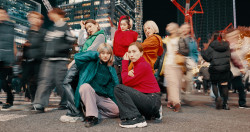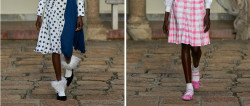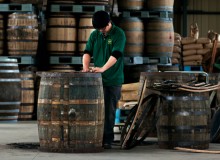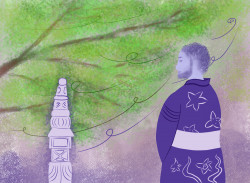
June 11, 2014
Back To The Future
Men's fashion in Tokyo doesn't need to be so avant-garde
By Metropolis
Originally published on metropolis.co.jp on June 2014

There can be no denying that the world of Japanese men’s fashion—for most of Tokyo’s international community, at least—remains a closed book. To most observers, the styles that tend to be synonymous with the city tend to be of the altogether “wacky” variety—likely to be a source of disapproving stares even beyond Tokyo. However, there is a world of credible men’s fashion lurking beyond the extremities, and one scene in particular that might hit surprisingly close to home.
The Tokyo vintage fashion scene is unique on the world stage, so from the outset you need to cast any and all visions of smelly thrift stores from your mind. It is also one with deep roots, arguably dating back to the publication of the seminal 1960s fashion photography book Take Ivy by Shosuke Ishizu that chronicled the fashion of America’s academic Ivy League elites, setting a precedent for taking inspiration from a fixed snapshot of foreign movements. That characteristic continues to this day with Malcolm McLaren-era Sex Pistols punk still reverberating on the streets of Tokyo, and ’90s fashion subcultures joining the fray under the “vintage” label. It is a cycle that fuels a significant portion of Tokyo fashion.
While a similar vintage scene can be found to some degree in most fashion capitals of the world, what really sets Tokyo apart is the fastidious approach to quality control that befits the city. Many shops here focus predominantly on “dead” (effectively new, unsold) stock, and even repair clothes to like-new condition before selling them. This obsessive attention to detail—one that treats vintage fashion as living, breathing antiques—helped to spawn the pockets of collectors in the back streets of Harajuku, Shimokitazawa and Koenji by the late 1990s, but it wasn’t until the “remake boom” of the 2000s that the fashion mainstream really took notice.
The process of remaking vintage clothes into new designs was a relatively unmarked revolution in Japanese fashion, sparking an ideological change in the minds of the ’90s lost generation, who could not afford the new luxury that baby boomers were consuming, but could create their own value by making new fashion out of pieces of the old. This was also the energy behind some of Japan’s most notable fashion ambassadors abroad, including the brand Undercover by Jun Takahashi and cult label Number (N)ine from Takahiro Miyashita, whose remix approach to ageless fashion staples continues to define modern Japanese couture from the street strata right up to the catwalk level.
Now, thanks to generations of genre splicing that have left the definition between new and vintage thoroughly blurred, we find ourselves up to date in present day Tokyo. It is the turn of the shops—rather than the fashion—to take center stage. In the post-vintage marketplace, many of Japan’s most recognizable street styles coveted abroad are ironically the curation of classic clothes imported from Europe and America. It is the crucial selection and coordination of these pieces into new styles by the shops themselves that opens up almost unlimited possibilities.
So, with shops catering to almost every possible iteration of menswear through the ages at your fingertips, and issues of sizing being far less common than even at Uniqlo, where do you start?
First, you have to make the difficult call as to whether you are happy to wear used clothes or not. If you choose the latter, that need not close doors entirely given that Tokyo’s vintage scene is positively bursting with enough unworn dead stock—from vaults of Levi’s jeans to Saville Row suits—to keep you classically attired for life. Add to that new brands indistinguishable from the vintage pieces sold side-by-side, and there really ought to be no barriers to getting the look.
The second step is to ground yourself in your comfort zone—whether it is a worn Schott Perfecto leather jacket of the Marlon Brando variety or a razor-sharp safari suit, your starting point should be one of personal identity and comfort. From there, insert an element of discord out of the original context to really make the look your own and contribute to the ongoing fashion conversation at large. Those tired of mainstream, trend-based fashion will be relieved to know that thanks to this heritage approach being largely outside the conventional Japanese system, you can be as indulgent as you like—safe in the knowledge that there really are no “rules” to break anymore.
Dante’s Look

Dante wears cult Tokyo label Blackmeans, with an ensemble that contrasts British heritage with LA skater culture. The wide leg shorts and t-shirt set-up riff on crust punk patchwork in stark polarity to the Barbour-style jacket often worn by the British Royal Family.
Finishing the look we have caramel and black bangles, which again contrast raised punk studs with smarter round ones. Pushing Dante’s own comfort zone we replaced his sneakers with 1970s vintage engineer boots.
All courtesy of Laboratory/Berberjin®
Key Areas
Harajuku
The first stop for the uninitiated is Harajuku, but don’t waste your time on the main streets or the tourist-friendly Takeshita dori. Head instead directly for the urahara—or back streets—of Harajuku, where you will find yourself spoiled for choice with friendly shops used to helping newcomers find their feet.
Koenji
Koenji quite rightly enjoys a reputation as the elite hunting ground for high-level vintage. While the area is currently known for younger, quirkier shops, the old guard still rule the roost, obsessing over rare Talon zips and only willing to pass on their hard-earned knowledge to the serious vintage hunter.
Shimokitazawa
With its reputation for foreigner-friendly hipster culture, it is no surprise to find cheaper vintage fashion for those determined to look like they are not making the effort. But looking beyond the likes of New York Joe, there is a healthy scene found clustered around the station catering to some very niche tastes.
Key Shops

Berberjin
Berberjin is a serious presence in Harajuku, and has six different shops in the backstreets area, with stock ranging from the accessible and affordable to very rare tour T-shirts likely to cost you a month’s salary. They even offer a loving repair service for vintage items, where you can get exact replicas for zips, buttons and conchos to keep your favorite gear alive and kicking.
www.berberjin.com

Qosmos
A relatively new addition to the Tokyo fashion landscape, Qosmos takes urban cult to its logical conclusion with a mixed and remixed approach to Freemason and secret society vintage pieces. It is as much a museum as it is a shop.
www.qosmos.jp

Bad-Nice
Why not complete the vintage look with a wet shave and trim at an old-school barber, such as Bad-Nice, Koenji? There is still a scattering of traditional Japanese shops in central Tokyo, but a new generation is picking up the mantle to keep the service alive against the ever-rising tide of the squeaky clean salon.
www.bad-nice.com
Key Brands

Vintage
Needless to say, for the truly authentic look you have to turn to vintage—and thankfully it is no great exaggeration to say that the best of the world’s vintage seems to be collected in Tokyo right now, so take advantage of the resources at your fingertips.
Blackmeans
This proudly “Made in Japan” brand has been catering to Tokyo’s serious bikers for the best part of a decade, but recent offerings have been some of the most progressive menswear the city has represented since the glory days of Jun Takahashi’s Undercover line. http://blackmeans.com
Kidill
This young brand’s first season is only just going on sale—in this case at the asylum-themed Honey’s Dead shop in Harajuku—but it has already made a name for itself among fashion insiders with designer Hiroaki Sueyasu’s ice-cold mix of formal wear and street fashion essentials. www.kidill.jp
Read part two: Beyond Geek Chic







